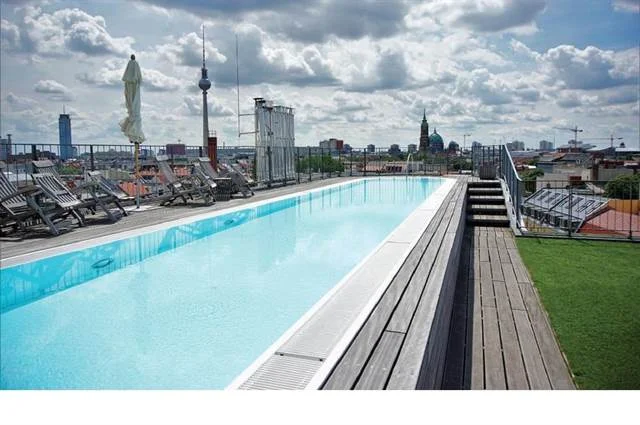Inside Berlin's Mitte and Charlottenburg | Two of the German Capital's Toniest Areas Dazzle Buyers
When Klaus Wowereit, a former mayor of Berlin, described his city as “poor, but sexy” in 2003, he was commenting on its growing appeal in the years following the fall of the Berlin Wall and German reunification.
At that time, young, creative types were flocking to the city, lured by its history, edgy urban vibe, affordable rents and empty spaces. Since then, the city has transformed itself into a world hub for contemporary art, dining, fashion, design and tech startups— and it is still a work in progress.
The exterior and pool in a Mitte Penthouse.
As a result, there has been an increase in the number of international buyers investing in the German capital’s property market, particularly in central neighborhoods such as Mitte and Charlottenburg.
Mitte, the once-neglected historic core of the city, which comprises the former East and West districts, includes some of the city’s most iconic attractions, such as Museum Island, Brandenburg Gate, and the Reichstag. Among its many new developments is Potsdamer Platz, a former Cold War wasteland rebuilt as a public square with futuristic buildings that house shops and offices.
West of Mitte is Charlottenburg, Berlin’s most elegant and traditional neighborhood, characterized by wide streets and refined parks and residential buildings. It is home to the 17th-century baroque Charlottenburg Palace and Kurfürstendamm, a leafy boulevard seen as Berlin’s version of the Champs-Élysées, lined with hotels, cafes, and designer boutiques.
Dining area in a Mitte Penthouse.
HOUSING STOCK
Mitte is mostly made up of apartments in deluxe new-build developments, says Monica Baier of Berlin Sotheby’s International Realty.
Her office is selling a 4,843-square-foot, five-bedroom duplex penthouse apartment in Mitte for €12 million euros. It has an indoor pool and a rooftop outdoor pool, which is surrounded by a decked terrace with sweeping views of Berlin.
Meanwhile, in Charlottenburg, apartment buildings mostly date from the late 19th- and early 20th-centuries and are built in Wilhelminian style, with high ceilings, large rooms, and attractive stucco facades. Berlin Sotheby’s International Realty is marketing a 1,948-square-foot renovated one-bedroom apartment in a 1910s building for €3.7 million. It has floorto- ceiling windows and an open-plan living room, with a designer kitchen and wooden flooring throughout.
A loft apartment in Charlottenburg.
Meanwhile, in Charlottenburg, apartment buildings mostly date from the late 19th- and early 20th-centuries and are built in Wilhelminian style, with high ceilings, large rooms, and attractive stucco facades.
Berlin Sotheby’s International Realty is marketing a 1,948-square-foot renovated one-bedroom apartment in a 1910s building for €3.7 million. It has floorto- ceiling windows and an open-plan living room, with a designer kitchen and wooden flooring throughout.
WHO LIVES THERE
Mitte and Charlottenburg attract similar types of buyers: They include investors, Berliners relocating within the city, and German and overseas second-home owners.
While Mitte and Charlottenburg are high-value areas, household types are diverse. Residents are a mix of single professionals, retirees, and families.
A loft apartment in Charlottenburg.
LUXURY AMENITIES
Top restaurants in Mitte include Borchardt, a Berlin institution since 1895 that serves French and German dishes; Grill Royal, an upmarket eatery serving oysters, steaks and seafood; and La Blanca at Hotel de Rome, which has a Mediterranean-inspired menu.
Most restaurants in Charlottenburg offer traditional and high-end international dining. Highlights include Grosz, which has the look of a Jazz Age cafe; Neni at the 25hours Hotel; and Restaurant Tim Raue, an eatery by the two-Michelin-starred Berlin chef of the same name.
Charlottenburg’s Kurfürstendamm and its charming side streets offer luxury retail labels, such as Louis Vuitton, Chanel, and Yves Saint Laurent, as well as independent shops and boutiques.
Mitte, meanwhile, has Friedrichstrasse, which provides designer brands such as Hugo Boss, Gucci, and Breitling.
The three best international schools in the area are in Mitte: Berlin Metropolitan School, which carries kindergarten through 12th grade; Berlin Cosmopolitan School, which offers an education for preschool to secondary students; and Phorms Campus Berlin Mitte, a bilingual German-English private nursery, primary, and secondary school.





